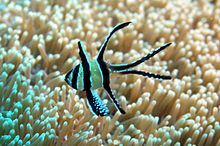Pterapogon kauderni
| Banggai cardinalfish | |
|---|---|
 |
|
| Scientific classification | |
| Kingdom: | Animalia |
| Phylum: | Chordata |
| Class: | Actinopterygii |
| Order: | Perciformes |
| Family: | Apogonidae |
| Subfamily: | Apogoninae |
| Genus: |
Pterapogon Koumans, 1933 |
| Species: | P. kauderni |
| Binomial name | |
|
Pterapogon kauderni Koumans, 1933 |
|
The Banggai cardinalfish (Pterapogon kauderni) is a small tropical cardinalfish in the family Apogonidae. It is the only member of its genus. This attractive fish is popular in the aquarium trade. It is among the relatively few marine fish to have been bred regularly in captivity, but significant numbers are still captured in the wild and it is now an endangered species.
This species is restricted to the Banggai Islands of Indonesia. This species has an extremely limited geographic range (5,500 km²) and small total population size (estimated at 2.4 million). The Banggai cardinalfish is composed of isolated populations concentrated around the shallows of 17 large and 10 small islands within the Banggai Archipelago. A small population also occurs off Central Sulawesi, within Luwuk harbor. One additional population has become established in the Lembeh Strait (North Sulawesi), 400 km north of the natural area of the species distribution, following introduction by aquarium fish traders in 2000. Small populations seen (May 2014) in Secret Bay, north west Bali (Banggai cardinal fish, Secret Bay, Bali)
This species grows up to 8 centimetres (3 in) total length. It is easily differentiated from all other cardinalfish by its tasseled first dorsal fin, elongate anal and second dorsal fin rays, deeply forked caudal fin, and color pattern consisting of three black bars across the head and body and prominent black anterior edges on the anal and second dorsal fin. The male can be differentiated from the female by a conspicuous enlarged oral cavity, which is apparent only when they are brooding.
The Banggai cardinalfish is the only member of its family that is diurnal. It is a demersal tropical marine fish that forms stable groups of about 9 individuals in shallow water, being most common at 1.5 to 2.5 meters in depth. It inhabits a variety of shallow habitats, including coral reefs, seagrass beds, and open areas of sand and rubble. It is most common in calm habitats on the protected side of larger islands. It is often found associated with the seagrass Enhalus acoroides and the long spined sea urchin Diadema setosum. It occurs among various living benthic substrates such as sea urchins, sea anemones, and branching corals; young fish are most commonly associated with sea anemones, while juveniles and adults occur most frequently among long-spined sea urchins and branching corals, as well as sea stars, hydrozoans, and mangrove prop roots. Individuals of 2 to 60 hover above the urchins, with the younger ones about 2 to 3 centimeters SL staying closest to them. The fish retreat among the spines when threatened. Individual fish exhibit well-defined homing behaviour and return to the original location of their group when disturbed. The Banggai cardinalfish often coexists with various anemonefish and anemone shrimp when sheltering in anemones and corals; when found among sea urchin spines, it associates with several other genera of cardinalfish. Following removal of the fish by aquarium collectors, the abundance of associated invertebrates has been shown to decline.
...
Wikipedia

